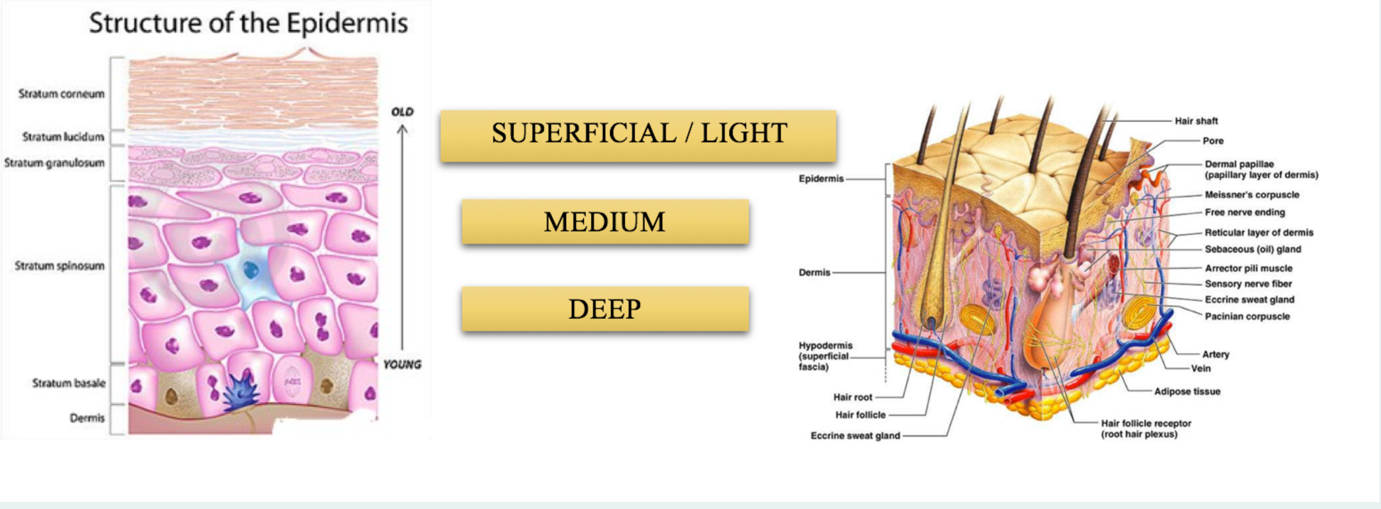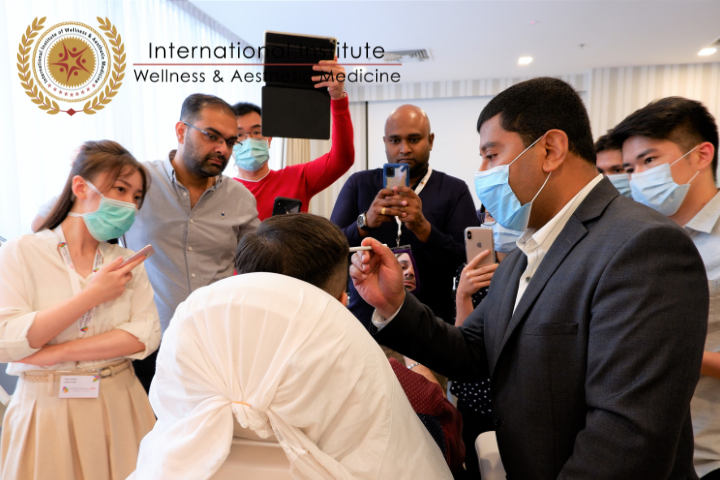Training on Chemical Peel Procedures
As one ages, the skin's regenerating capability tends to get reduced, causing the old dead skin cells to accumulate on top making the skin look dull and patchy. Chemical peeling is a safe and effective method for the treatment of aging skin, various skin disorders such as ichthyosis Vulgaris and keratosis pillaris and to refresh and rejuvenate the overall skin.
At Aesthetic Academy Asia, we have a team of Certified doctors that impart comprehensive clinical knowledge and hands-on-training to doctors, dentists, Aesthetic Nurses, Aestheticians, and spa owners in the field of Aesthetic medicine. Aesthetic Academy Asia is based in Malaysia and receives Aesthetic students from the Philippines, Myanmar, Cambodia, India, Indonesia, and other parts of Asia. Assoc. Prof Dr. Morthy is the lead trainer and course director for the region. He is also the medical director of Global Aesthetic (www.globalAesthetic.com) which offers advanced Aesthetic medical procedures. Aesthetic Academy Asia with the insignia of “Be Certified, Be Recognized” has always stressed the importance of structured Aesthetic medical education with international recognition for those opting for a career in Aesthetic Medicine.
Under our Advanced Aesthetic Diploma courses in Malaysia and our International Online Aesthetic courses, Aesthetic students are trained extensively on the application and benefits of various chemical peel procedures to improve the evenness of skin color and texture. These procedures help to create a youthful look and restore a healthy, luminous, and radiant appearance.
In today’s article, we will talk about chemical peels, its various types and why you need proper training in chemical peeling.
What is chemical peeling?
Chemical peeling is a method of targeted cutaneous chemo-exfoliation by specific caustic agents that allows for a rapid, predictable, and uniform thickness of exfoliation to a desired cutaneous depth, ultimately resulting in improvement in the overall appearance of skin. The main aim of a chemical peel procedure is to remove a uniform thickness of damaged and aged skin in a controlled manner and subsequently allows for normal wound healing and skin rejuvenation to occur. It is important for the aesthetic practitioner to be in control of the exfoliation and inflammation in order to minimize complications, such as scarring and post-inflammatory hyperpigmentation.

How is a chemical peel performed?
The caustic agents used for chemical peels cause controlled kerato-lysis or kerato-coagulation. In both kerato-lysis or kerato-coagulation, there will be denaturation of the proteins within the epidermis and dermis, resulting in the exfoliation of the layers of the skin and release of proinflammatory cytokines and chemokines. Such targeted and controlled inflammation activates the normal healing signal cascade, including stimulation, development, and deposition of new dermal collagen and elastin, reorganization of structural scaffold proteins and dermal connective tissue, and regeneration of new keratinocytes. This results in rejuvenation and thickening of the epidermis and an increase in dermal volume. In simpler terms, the new, regenerated skin is usually smoother and healthier than the old skin. In contrast to most believes that regular chemical peel thins out the skin, regular chemical peel actually increases dermal matrix and thickness.
Types of Chemical Peel Procedures
Here are some of the most common chemical peel procedures to improve the evenness and texture of the skin to create healthy, luminous, and radiant skin.

Superficial or Lunchtime Peel
Superficial peels result in mild and controlled exfoliation of the cells present in the superficial layer of the epidermis, which extends from the corneal cell down to the stratum granulosum cell layer. The goal of superficial peeling is to treat conditions within the epidermis layer while minimizing recovery downtime and the risk of side effects. In today’s time, superficial peels largely use low-to-medium strength alpha-hydroxy acids (AHA) (30% – 50% glycolic and 10% – 30% lactic acid) and, more recently, 40% mandelic acid. Additionally, low concentrations or monolayer applications of beta-hydroxy salicylic acid (30%) or alpha-keto pyruvic acid (50%) have proven to be for excellent superficial chemo exfoliation as well. The treatment is used to improve the appearance of mild skin discoloration and rough skin as well as to refresh the face, neck, chest, or hands.
Medium Peel
Medium-depth peels allow for controlled exfoliation throughout the entire epidermis. This results in deeper regenerative changes that can target both within the epidermis and the superficial dermis and can often be performed in a single setting. When used appropriately and with proper technique, medium-depth peels are highly effective in the treatment of fine rhytides, chronic actinic photodamage, superficial hyperpigmentary disorders (e.g., melasma), and superficial acne scars.
Some of the most common chemical agents currently used for medium-depth peeling are 70% glycolic acid and 35% to 50% TCA, with or without adjuvant combination products (e.g., Jessner’s solution [comprising 14g resorcinol, 14g salicylic acid, 14mL lactic acid in ethanol constituted to 100mL]. In addition, multiple layered applications of 20% to 40% salicylic acid and pyruvic acid are also used for medium-depth peeling, though not traditionally considered medium-depth peels.
Deep Peel
During the deep peel procedure, 50% Glycolic acid + 50% trichloroacetic acid or 80% phenol, such as the Baker-Gordon formula, is applied to penetrate the deeper layers of the skin. The exfoliation depth here includes the entire epidermis and upper dermis. The treatment removes moderate lines, age spots, freckles, and shallow scars. The procedure is used on the face and can be performed once a year. The ideal candidate for deep peeling procedures is a patient with moderate-to-severe photoaging skin (e.g., chronic actinic damage with deeply furrowed rhytids and/or significant hyperpigmentation).
Please note that this is a very dangerous and high-risk procedure that must be done upon proper training only. The patient must be well prepared in advance by priming the skin, proper counselling, post-op pain management, wound care and the doctor must be ready to manage any complications if it arises.
Why is training important?
Though most people are of the opinion that chemical peels are very safe, the truth is chemical peel procedures can be dangerous if administered incorrectly.
It is important for the aesthetic practitioners to be well trained in terms of principle of chemical peel, types of chemical peel, concentrations, application techniques, depth of penetration, and neutralizing the peels so that they are able to properly administer the chemical peel treatment. Complications of chemical peels include chemical burns which can be so intense to a point it may cause discoloration of the skin, scarring, infection, reactivation of herpes simplex infections, and even facial disfigurement. Thus, proper education is very important in order to not only avoid but also to teach them to manage these complications.
At Aesthetic Academy Asia, the aesthetic doctors & aesthetic dentists are intensively trained in theory as well as clinical skills under our advanced aesthetic courses in the chemical peel so that they can execute the cosmetic procedure, safely and effectively.
Similarly, Aesthetic nurses, aestheticians, and spa owners are also trained to understand the basic principles of chemical peel under our cosmetology certification programme in a chemical peel.
The advanced aesthetic courses in the chemical peel curriculum includes:
-
What are the types of a chemical peel?
-
What are the layers of the skin?
-
What are the principles of a chemical peel?
-
What is chemical-tissue interaction?
-
How does a chemical peel work?
-
What are chemical peel complications?
-
How to avoid chemical peel complications?
-
How to treat chemical peel burns?
-
Which are the safest chemical peels?
Aesthetic Education at Aesthetic Academy Asia
At renowned Aesthetic Academy Asia, may it be for students from the Philippines, Myanmar, India, Cambodia, Indonesia, or any part of the world, we take Aesthetic education with utmost seriousness and help our students learn and practice effective Aesthetic procedures so they are confident enough to start their career in Aesthetic. Our students are well versed to handle any situation, simply because we focus on teaching the fundamentals and principles of the Aesthetic procedures before venturing into clinical skills. Our students learn advanced and new skills and techniques that are different than the textbooks. We teach them safe, effective, and affordable ways to perform Aesthetic procedures. In addition to the Professional Diploma in Aesthetic Medicine for Doctors & Dentists and Professional Certificate in Advanced Aesthetic for Nurses, Aestheticians and Spa Owners, Aesthetic Academy Asia also conducts specialized and advanced training such as Non-Surgical Body Sculpting, Dermal Filler (Restylane, Juvederm, Teosyal, Bellotero), Botulinum Toxin (Botox, Dysport, Xeomin), Skin Boosters (Restylane Skin Booster, Profhilo, Rejuran) Platelet Rich Plasma (PRP), Threadlift (PDO, Aptos, Happy Lift) and more. Now with the current pandemic, the Academy is conducting online Professional Diploma in Aesthetic Medicine and online Professional Certificate in Advanced Aesthetic courses using state of the art virtual meeting technology.
The Academy has produced have some of the finest Aesthetic graduates in the world who have graduated from our professional aesthetic courses with dual international certificates.

